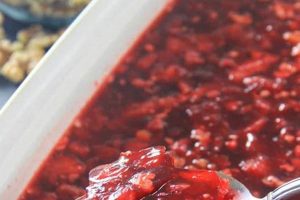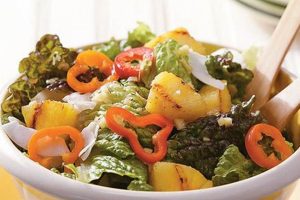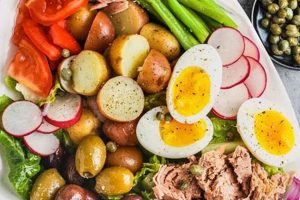A dish composed of dandelion greens, typically the younger, more tender leaves, combined with other ingredients to create a palatable salad. Variations can include additions such as bacon, croutons, hard-boiled eggs, various cheeses, and a variety of dressings. A simple vinaigrette is a popular choice, often incorporating ingredients like lemon juice, olive oil, and spices.
Such a salad offers nutritional benefits due to the dandelion’s rich vitamin and mineral content, including vitamins A, C, and K, as well as potassium and iron. Historically, dandelions have been valued for their medicinal properties and used in various culinary traditions. Foraging for dandelion greens can be a sustainable practice, providing locally sourced, seasonal nutrition.
This exploration will further delve into specific preparation methods, including safe identification and harvesting of dandelions, optimal techniques for preparing the greens, and a variety of complementary ingredient combinations and dressing recipes. Nutritional information and potential health considerations will also be addressed.
Tips for Preparing Dandelion Salad
Proper preparation is essential for a palatable and enjoyable dandelion salad. These tips offer guidance on selecting, handling, and combining ingredients for optimal results.
Tip 1: Harvest young leaves. Younger dandelion leaves, preferably before the plant flowers, offer a milder, less bitter flavor. Mature leaves can be used but may require blanching to reduce bitterness.
Tip 2: Identify dandelions correctly. Ensure accurate identification to avoid consuming toxic look-alikes. Consult reputable foraging guides or experienced foragers if uncertain.
Tip 3: Clean greens thoroughly. Rinse dandelion greens meticulously to remove soil, insects, and other debris. Soaking in cold water can help dislodge stubborn particles.
Tip 4: Balance bitterness. The characteristic bitterness of dandelion greens can be balanced with complementary flavors. Sweet, acidic, and salty ingredients, such as bacon, dried cranberries, or a citrus vinaigrette, can effectively counteract bitterness.
Tip 5: Experiment with additions. Various ingredients can enhance the flavor and texture. Consider incorporating nuts, cheeses, croutons, or other vegetables for added variety and nutritional value.
Tip 6: Blanch mature leaves (optional). Blanching older dandelion greens in boiling water for a brief period can reduce bitterness and improve texture.
Tip 7: Dress immediately before serving. To prevent the greens from wilting, add the dressing just before serving. This preserves the salad’s freshness and crispness.
By following these tips, one can create a flavorful and nutritious salad showcasing the unique qualities of dandelion greens.
These preparatory techniques contribute to a more enjoyable culinary experience, allowing for full appreciation of this versatile ingredient.
1. Ingredients
Ingredient selection significantly impacts the flavor profile, nutritional value, and overall success of a dandelion salad recipe. The inherent bitterness of dandelion greens necessitates careful consideration of complementary ingredients. Balancing bitterness with contrasting flavors, such as acidity, sweetness, or saltiness, is crucial. For example, acidic elements like lemon juice or vinegar in a vinaigrette cut through the bitterness, while sweet components like dried cranberries or roasted beets provide a counterpoint. Salty ingredients, such as bacon or crumbled feta cheese, add depth and further balance the flavor profile. The choice of ingredients also affects the texture and nutritional content of the salad. Incorporating nuts adds crunch and healthy fats, while additions like hard-boiled eggs contribute protein and creaminess.
The quality and freshness of ingredients also play a vital role. Freshly harvested dandelion greens, preferably young and tender, offer the best flavor and texture. Using high-quality oils, vinegars, and other components enhances the overall sensory experience. Furthermore, considering seasonal ingredients allows for optimal flavor and nutritional value, reflecting the natural availability of produce. Local sourcing of ingredients, when possible, supports sustainable practices and often yields superior quality.
Understanding the interplay of ingredients within a dandelion salad recipe is essential for crafting a delicious and balanced dish. Strategic ingredient selection transforms the potentially overpowering bitterness of dandelion greens into a nuanced and enjoyable flavor profile. Prioritizing fresh, high-quality ingredients maximizes both the nutritional and sensory aspects of the salad. This knowledge empowers culinary experimentation, allowing for the creation of diverse and personalized variations that cater to individual preferences and dietary needs.
2. Preparation
Preparation is paramount to a successful dandelion salad recipe, impacting both palatability and enjoyment. Proper techniques mitigate the inherent bitterness of dandelion greens and enhance their unique flavor profile. The following facets highlight the crucial role of preparation:
- Cleaning and Handling
Thorough cleaning is essential. Dandelion greens, often foraged, require meticulous rinsing to remove soil, insects, and debris. Soaking in cold water for a short period aids in dislodging stubborn particles. Gentle handling prevents bruising and maintains the integrity of the leaves.
- Bitterness Reduction
Several methods can reduce bitterness. Blanching, a brief immersion in boiling water followed by an ice bath, softens the leaves and mitigates the strong flavor. Soaking in cold, salted water for 30 minutes can also draw out bitterness. Selecting younger leaves, harvested before the plant flowers, naturally offers a milder taste.
- Ingredient Combination
Strategic ingredient combinations balance the dandelion’s bitterness. Acidic elements like lemon juice or vinegar, sweet components such as dried fruit or roasted beets, and salty additions like bacon or cheese create a harmonious flavor profile. The interplay of these contrasting elements elevates the overall sensory experience.
- Dressing and Timing
The choice and timing of dressing application impact the salad’s final quality. A light vinaigrette, applied just before serving, prevents the delicate greens from wilting and maintains their crispness. Heavy dressings can overwhelm the subtle flavors of the dandelion and other ingredients.
These preparatory steps are fundamental to creating a delicious and enjoyable dandelion salad. Careful attention to cleaning, bitterness reduction techniques, ingredient combinations, and dressing application ensures a balanced flavor profile and optimal texture. Proper preparation transforms this often-overlooked ingredient into a culinary delight.
3. Seasoning
Seasoning plays a critical role in a dandelion salad recipe, elevating the inherent flavors of the ingredients and balancing the characteristic bitterness of the greens. Careful consideration of seasoning choices transforms a simple salad into a nuanced culinary experience. The following facets highlight the crucial role of seasoning:
- Balancing Bitterness
Seasoning choices directly address the inherent bitterness of dandelion greens. Acidity, often introduced through vinegar or citrus juice, cuts through the bitterness. Sweet elements, such as a touch of honey or maple syrup, offer a contrasting flavor profile. Salty components, like sea salt or crumbled cheese, further balance the overall taste and enhance other ingredients.
- Enhancing Complementary Flavors
Seasoning not only balances bitterness but also enhances the flavors of accompanying ingredients. A well-chosen vinaigrette, for instance, complements the nutty notes of toasted walnuts or the earthiness of roasted beets. Spices, such as black pepper or a pinch of red pepper flakes, add depth and complexity to the overall flavor profile.
- Creating Flavor Complexity
Strategic use of herbs and spices adds layers of flavor. Fresh herbs like chives, parsley, or mint provide brightness and a fresh counterpoint to the dandelion greens. Dried spices, used sparingly, introduce warmth and depth. The combination of various seasonings creates a more complex and interesting culinary experience.
- Highlighting Textural Contrasts
Seasoning can also highlight textural contrasts within the salad. A sprinkle of flaky sea salt enhances the crunch of croutons or toasted nuts. A squeeze of lemon juice brightens the creamy texture of goat cheese or a soft-boiled egg. The interplay of textures and flavors, amplified by appropriate seasoning, elevates the overall sensory experience.
The interplay of these seasoning elements is essential for a well-balanced and flavorful dandelion salad. Strategic seasoning choices not only mitigate bitterness but also create a harmonious blend of flavors and textures, transforming a potentially challenging ingredient into a culinary highlight.
4. Presentation
Presentation significantly influences the perceived value and enjoyment of a dandelion salad recipe. While flavor and nutritional content remain paramount, visual appeal enhances the dining experience. Thoughtful presentation elevates the dish from a simple combination of ingredients to a more engaging culinary creation.
- Color and Contrast
Visual appeal begins with color. The vibrant green of dandelion greens provides a base for contrasting elements. Incorporating ingredients with varied hues, such as the deep red of radicchio, the bright orange of carrots, or the rich purple of beets, creates visual interest. The interplay of colors enhances the overall presentation and stimulates appetite.
- Texture and Height
Texture plays a crucial role in visual appeal. The slight roughness of dandelion greens contrasts with the smooth texture of hard-boiled eggs or the crunch of toasted nuts. Creating height within the salad, by layering ingredients or incorporating elements like croutons, adds dimension and visual interest. This interplay of textures further enhances the dining experience.
- Plating and Garnishing
The choice of servingware and garnishes contributes to the overall presentation. A simple white plate allows the colors of the salad to stand out. Garnishes, such as edible flowers, a sprinkle of cheese, or a drizzle of dressing, add a finishing touch. Careful plating elevates the perceived value of the dish and enhances its visual appeal.
- Context and Occasion
Presentation adapts to the context of the meal. A casual lunch may warrant a simple presentation in a bowl, while a formal dinner may benefit from a more elaborate arrangement on individual plates. The occasion influences the choice of servingware and garnishes, further tailoring the presentation to the specific dining experience.
Consideration of these presentational aspects elevates the dandelion salad recipe from a simple dish to a more refined culinary experience. The interplay of color, texture, plating, and context enhances visual appeal and overall enjoyment. While flavor and nutritional value remain essential, thoughtful presentation adds a layer of sophistication and elevates the perceived value of the dish.
5. Nutritional Value
Nutritional value represents a significant aspect of dandelion salad recipes, contributing to their appeal beyond mere culinary interest. Dandelion greens, often overlooked, offer a surprising wealth of vitamins, minerals, and antioxidants, positioning the salad as a nutrient-dense food choice. Understanding the nutritional composition of these greens provides insight into their potential health benefits and underscores the importance of incorporating them into a balanced diet.
- Vitamin and Mineral Content
Dandelion greens are a rich source of vitamins A, C, and K. Vitamin A supports vision and immune function, while vitamin C acts as an antioxidant and contributes to collagen production. Vitamin K plays a vital role in blood clotting and bone health. These greens also provide essential minerals, including potassium, crucial for maintaining fluid balance and blood pressure regulation, and iron, necessary for red blood cell production and oxygen transport.
- Antioxidant Properties
Dandelions contain antioxidants, compounds that protect cells from damage caused by free radicals. These antioxidants, including beta-carotene and polyphenols, contribute to overall health and may play a role in reducing the risk of chronic diseases. The antioxidant capacity of dandelion greens further enhances their nutritional value and contributes to their potential health benefits.
- Fiber Content
Dandelion greens offer a good source of dietary fiber, important for digestive health. Fiber promotes regularity, helps maintain a healthy gut microbiome, and contributes to satiety, potentially aiding in weight management. The fiber content of dandelion greens adds another dimension to their nutritional profile and supports overall well-being.
- Bioactive Compounds
Beyond vitamins, minerals, and fiber, dandelions contain various bioactive compounds, including flavonoids and sesquiterpene lactones. These compounds contribute to the plant’s distinct flavor profile and may offer additional health benefits, such as anti-inflammatory and diuretic effects. Research continues to explore the potential therapeutic properties of these bioactive compounds.
The nutritional profile of dandelion greens significantly contributes to the overall health benefits of incorporating dandelion salad into one’s diet. The combination of vitamins, minerals, antioxidants, fiber, and bioactive compounds positions this often-overlooked plant as a nutrient-dense food source with potential health-promoting properties. Understanding this nutritional complexity allows for a more informed appreciation of dandelion salad as a valuable addition to a balanced and health-conscious dietary approach.
6. Variations
Variations within dandelion salad recipes demonstrate the versatility of this often-overlooked ingredient. Adaptability to diverse flavor profiles and dietary preferences positions the dandelion salad as a customizable culinary creation. Exploring these variations highlights the potential of dandelion greens to transcend their inherent bitterness and integrate into a wide range of culinary contexts.
- Cultural Adaptations
Culinary traditions worldwide incorporate dandelion greens in diverse ways. Greek cuisine, for example, often pairs dandelion greens with lemon and olive oil, reflecting the region’s readily available ingredients. Italian cuisine incorporates dandelion greens into pasta dishes or serves them sauted with garlic. These cultural adaptations showcase the global acceptance of dandelion greens and their adaptability to regional flavors.
- Ingredient Combinations
The inherent bitterness of dandelion greens allows for a wide range of complementary ingredients. Sweet elements, such as dried cranberries, roasted beets, or a honey-based vinaigrette, counteract bitterness and add complexity. Salty ingredients, including bacon, feta cheese, or toasted nuts, provide a savory counterpoint and textural contrast. Acidic components, like lemon juice or vinegar, cut through the bitterness and brighten the overall flavor profile. Such variations demonstrate the adaptability of dandelion greens to diverse flavor combinations.
- Dietary Adaptations
Dandelion salad recipes easily adapt to various dietary restrictions. Vegan variations may substitute bacon with smoked tofu or mushrooms, while gluten-free versions utilize gluten-free croutons or omit them altogether. Dairy-free options replace cheese with nutritional yeast or avocado. These adaptations demonstrate the inclusivity of dandelion salad and its potential to accommodate diverse dietary needs.
- Seasonal Variations
Seasonal ingredients further enhance the versatility of dandelion salad. Spring variations might incorporate fresh asparagus or peas, while summer versions include ripe tomatoes or cucumbers. Autumn variations utilize roasted root vegetables like sweet potatoes or parsnips, and winter versions incorporate dried cranberries or pomegranate seeds. These seasonal adaptations reflect the adaptability of dandelion salad to year-round enjoyment and highlight the potential for incorporating locally sourced, seasonal produce.
The multitude of variations within dandelion salad recipes underscores the adaptability and culinary potential of this often-discarded green. From cultural adaptations to ingredient combinations and dietary considerations, the dandelion salad demonstrates its versatility and relevance within a wide range of culinary contexts. Exploring these variations allows for a deeper appreciation of the dandelion’s capacity to transcend its perceived limitations and become a star ingredient in diverse and delicious culinary creations.
Frequently Asked Questions
This section addresses common inquiries regarding dandelion salad recipes, providing clear and concise information to facilitate successful preparation and enjoyable consumption.
Question 1: How does one mitigate the bitterness of dandelion greens?
Several methods effectively reduce bitterness. Blanching the leaves briefly in boiling water, then plunging them into ice water, diminishes the strong flavor. Soaking in cold, salted water for 30 minutes also draws out bitterness. Selecting younger, more tender leaves, harvested before the plant flowers, naturally offers a milder taste.
Question 2: Are all dandelion varieties safe for consumption?
While all true dandelions are edible, accurate identification is crucial to avoid consuming potentially toxic look-alikes. Consulting reputable foraging guides or experienced foragers is recommended, especially for novice foragers. If uncertainty exists, err on the side of caution and refrain from consumption.
Question 3: What are ideal complementary ingredients for dandelion salad?
Ingredients offering contrasting flavors and textures create balance. Acidic elements like lemon juice or vinegar cut through bitterness. Sweet components, such as dried cranberries or roasted beets, offer a counterpoint. Salty and savory additions like bacon, cheese, or toasted nuts provide depth and complexity.
Question 4: When should the dressing be added to a dandelion salad?
To prevent the greens from wilting, dressing application should occur immediately before serving. This preserves the salad’s freshness and crispness, maximizing textural appeal and preventing a soggy consistency.
Question 5: What are the nutritional benefits of consuming dandelion greens?
Dandelion greens are a rich source of vitamins A, C, and K, as well as minerals like potassium and iron. They also offer antioxidants and fiber, contributing to a nutrient-dense food choice. These nutrients support various bodily functions, including vision, immune function, blood clotting, and bone health.
Question 6: How should dandelion greens be stored for optimal freshness?
Freshly harvested dandelion greens should be stored similarly to other leafy greens. Wrapping them in a damp paper towel and placing them in a sealed container or plastic bag within the refrigerator preserves freshness for several days. Prompt consumption ensures optimal quality and nutritional value.
Careful preparation, ingredient selection, and understanding of dandelion greens’ unique properties contribute to a successful and enjoyable culinary experience. These considerations ensure that the inherent nutritional benefits and unique flavor profile of this often-overlooked ingredient are fully appreciated.
Further exploration of specific dandelion salad recipes and culinary techniques provides additional avenues for integrating this versatile ingredient into a balanced and health-conscious diet.
Conclusion
Exploration of dandelion salad recipes reveals a versatile and nutritionally valuable culinary opportunity. Careful preparation, including proper cleaning and bitterness reduction techniques, unlocks the full potential of this often-overlooked ingredient. Strategic ingredient pairings, balancing bitterness with complementary flavors and textures, create a harmonious and palatable dish. Understanding the nutritional profile, rich in vitamins, minerals, and antioxidants, further elevates the dandelion salad beyond mere sustenance.
Culinary experimentation with dandelion greens offers a pathway to both novel flavor experiences and enhanced nutritional intake. This readily available, often foraged ingredient provides a sustainable and accessible culinary resource. Continued exploration of dandelion salad recipes promises further culinary discoveries and encourages a deeper appreciation for the potential of readily available, yet often underutilized, ingredients.






